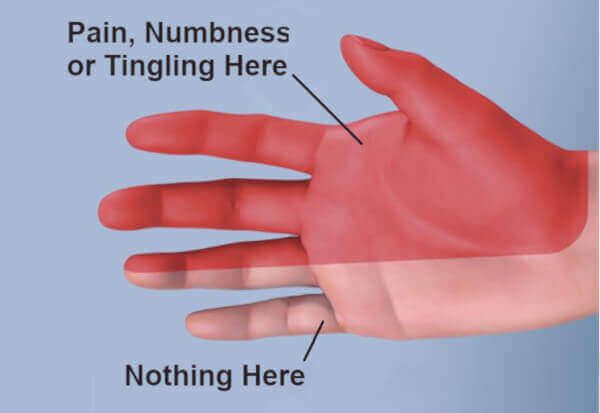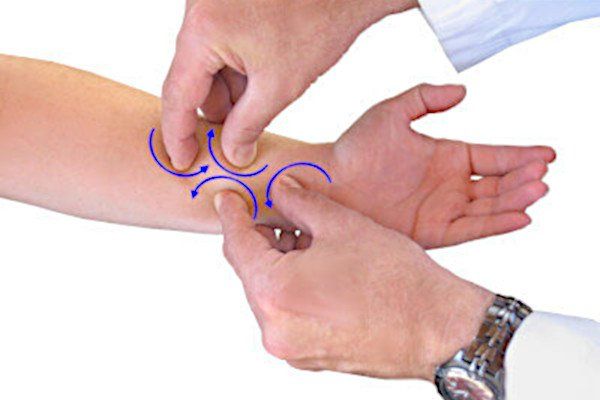Carpal Tunnel Syndrome: Symptoms & Treatment
From Dr. Z - Carpal tunnel syndrome specialist
Carpal Tunnel Syndrome: Symptoms & Treatment
Carpal tunnel syndrome is mainly characterized by severe numbness or pain in your fingers and hand. Some patients have such severe symptoms that numbness or pain (or both) dominate every aspect of their life.
In the most extreme cases, symptoms are continuous, without any relief. Many patients say their hand is so painful that it feels like it's in a vice. Or the numbness is so intense that it's described as "punishing" or "cruel".
For sure, symptoms were not as bad in the beginning. Warning signs appeared, like waking up at night to shake out your hands. Even simple tasks like grasping a cup or phone wasn't easy. Perhaps you ignored occasional fumbling with keys or coins. Or maybe you found yourself dropping things a lot. If you didn't take care of the problem then, it escalated to where it is now.
The good news is that you don't need to suffer - even if you have severe symptoms of carpal tunnel syndrome. There are highly effective and approved treatments for getting rid of symptoms completely and for good. Best of all, you don't need hand surgery because these are nonsurgical therapies.
Here's the catch: every nonsurgical therapy requires dedication to the regimen every day for 1-2 months. If you can commit to that, then read more below about each of those therapies.
Carpal tunnel symptoms
This article started by describing the major symptoms of carpal tunnel syndrome. You should be aware that no two people will feel the exact same things. But in general, you can have one or more of these symptoms in your fingers or hand. (Note, the little finger is never involved.)
Symptoms are listed from the most to least common complaints of carpal tunnel syndrome.
- Numbness
- Pain (any combination of sharp, dull, aching, throbbing, soreness)
- Shooting electric shocks
- Weakness (particularly grip strength)
- Tingling (prickling or pins-and-needles)
- Burning
- Puffy or swollen feeling
- Clumsiness
- Itching
Any one of these symptoms can be constant or intermittent. When carpal tunnel syndrome first begins, these symptoms (particularly numbness and pain) occur when trying to sleep. Sufferers frequently wake up needing to rub out the pain or shake out the numbness.
As carpal tunnel progresses, these and other symptoms are apparent during the daytime, too. If they appear while your hand is working, it usually indicates the disorder is well-developed. At this point, and if left untreated, the probability of it worsening over the next 6 months is about 66%.
Finally, carpal tunnel syndrome is a bilateral condition. That means, over 88% of the time symptoms will appear on the other hand within one year. Having both hands out of commission can be a real problem. This is why early treatment is crucial.
The 4 steps to eliminate symptoms
It may seem like the intense symptoms of carpal tunnel syndrome are here to stay. And if you don't do something about it, you'd be correct. Usually, severe carpal tunnel symptoms won't just disappear on their own.
The great news is that it's relatively simple to get rid of symptoms. And when you do, you'll ask yourself, "Why didn't I do this a long time ago?"
Hand surgery is not the answer. Surgery is successful nearly 90% of the time - but only immediately afterward. Within 2 years, 57% of carpal tunnel surgery patients are not satisfied with their results. Why? Either symptoms return or patients have prolonged and persistent pain.
Therapists have been treating carpal tunnel patients for decades - and without surgery. Therapists usually have an 80% to 90% success rate. Even more, the results they get are permanent in most patients.
The techniques therapists use are Night Bracing, Rest, Exercise, and Massage. As any therapist will advise you, a commitment to all four of these components for 30 days will completely eliminate symptoms in most patients.
Here's the simple prescription to eliminate carpal tunnel symptoms:
- Follow each of the 4 techniques below twice a day.
- You must do ALL four components.
- Do them for 30 days.
Step 1: Night Bracing
Wear a night brace to bed.
It's important to brace your hand and wrist at night while you sleep. We all unconsciously bend our hands backward while we we're asleep. This exerts tremendous pressure inside our wrist joint. The pressure further damages the median nerve, which is already injured from carpal tunnel syndrome.
A night brace will maintain your hand in the neutral position (meaning "straight"). This exerts the least amount of pressure inside the wrist joint.
But never wear a brace during the daytime. Why?
During the day, wearing a wrist restriction will worsen carpal tunnel syndrome. Your hand will subconsciously fight the brace while it's also trying to perform it's regular job. This "extra work" is harmful if you have either carpal tunnel syndrome or wrist tendonitis
(See if you have carpal tunnel syndrome or wrist tendonitis by taking this self-test.)
Finally, be sure to wear a "certified" carpal tunnel brace. You cannot buy these in your local pharmacy like Walmart, CVS, Rite Aid or Walgreens. And be watchful; even though the package says "for carpal tunnel syndrome" - it usually isn't.
How can you tell if it's a good or bad brace? All ordinary wrist braces (which are bad for carpal tunnel) have a "palmar spine" or stiffener. The image below illustrates this. That spine can push into your wrist joint and increase the pressure inside. Such pressure is harmful if you already have carpal tunnel syndrome.
In contrast, a certified carpal tunnel brace has no such spine on the palm surface. Instead, it's located on the top or side of the hand.
See
this link for a list of certified carpal tunnel braces.
Step 2: Rest
Take regular rest breaks from stressing your hand.
You might not be aware of it but you can be stressing your hand right now. Hand stress or strain can come in many forms such as:
- Repetitive and rapid motion (typing)
- Bending the hand forcefully (golfing)
- Constantly grasping and releasing (using a hair brush)
- Repeatedly grasping forcefully and releasing (shoveling)
- Twisting your hand and wrist (using a screwdriver)
- Pinching repeatedly (using a scissors)
- Holding your hand in a bent position (carrying heavy objects)
If you have carpal tunnel syndrome but still need to work with your hands, taking a break from these activities is enormously important. It gives your hand a short time to restore blood flow, which oxygenates strained tissues.
Rest doesn't necessarily mean you must lie down and do nothing. It means temporarily not performing (or avoiding) stressful hand activity. (Permanent avoidance would be better, but you probably can't change jobs to achieve that).
Simply taking a short break from stressful activity could mean:
- Stop what you're doing, drop your hands to your sides, and shake them out to encourage blood circulation.
- Take 1-2 minutes to do stretching exercises (see below).
- Switch hands to perform an activity so part of the strain is distributed to the other hand.
- Change the position or angle of your hand while it's performing a particular duty.
Step 3: Exercise
Do regular carpal tunnel stretching exercises.
There are special stretching exercises designed just for carpal tunnel syndrome. They're special because they lubricate flexor tendons and also break up adhesions on the tendons. This goes a long way to eliminating carpal tunnel symptoms.
These stretching exercises are effective and also quick to complete. Why is speed important?
Most people who work with their hands don't have time to perform hand exercises for 20 minutes. But all of these special carpal tunnel stretches can be completed in under 2 minutes. That's certainly manageable for even the busiest hands.
Do the following 4 core carpal tunnel stretching exercises shown in the image above. You must do them every 1-3 hours you work with your hands. The more severe your symptoms, the more often you should do them.
These exercises are described in more detail at this link. They are composed of the following:
- Prayer Stretch:
This exercise lubricates the entire length of your flexor tendons, from your fingers to your forearm.
- Stop Stretch: Concentrating the stretching force inside the wrist joint insures removal of restrictions which cause carpal tunnel syndrome.
- Finger Interlace Stretch: This is similar to the Stop Stretch, but also includes stretching the finger muscles (lumbricals).
- Thumb Stretch: Stretching the thumb is crucial because it's the finger most affected by carpal tunnel syndrome.
Step 4: Massage
Perform myofascial release massage on your forearm.
The best is saved for last. Myofascial release massage is a specialized form of deep tissue massage. It's designed to knead and twist tissues below the skin.
When myofascial release is performed over the lower forearm, the mechanical action affects the flexor tendons below. It serves to break up tendon adhesions which restrict their movement. Those adhesions are the root cause of carpal tunnel syndrome.
The other effect of myofascial release massage is that it drains excess fluid from inside your wrist joint. That fluid build-up exerts pressure on the median nerve, causing symptoms to worsen.
Myofascial release massage is highly effective against mild, moderate or severe stages of carpal tunnel syndrome. And patients usually see significant results in 4-6 weeks, depending on initial severity.
But there's a downside to this remedy. First, myofascial release massage cannot be performed by the patient. It requires a person to use the thumbs and forefingers of both hands to produce that kneading action on a patient. A partner can certainly learn how to do it. But most patients see a therapist for this treatment.
The second downside of myofascial release massage is that is must be performed once a day (at a minimum) for at least 30 days. Twice a day is best to get good results. Seeing a therapist daily for up to 6 weeks can cost $20 to $60 per 30 minute session. The CarpalRx performs the same therapy automatically.
Results you'll get
Using the 4 techniques listed above, most patients see complete resolution of symptoms in about 4 weeks. More severe symptoms may take a few weeks longer.
The most important recommendation for using these techniques is persistence. No matter how mild or severe your symptoms, you should not skip daily treatment sessions nor take short-cuts. But if you commit to daily treatment times, your carpal tunnel symptoms are almost guaranteed to disappear.
Conclusion
Carpal tunnel syndrome is characterized by pain, numbness, tingling, weakness and other symptoms in the hand and fingers. The best way to eliminate these symptoms without surgery is to use 4 remedies simultaneously. They are Night Bracing, Rest, Exercise, and Massage. When performed simultaneously and for 4-6 weeks, these techniques will relieve all symptoms of carpal tunnel syndrome. In fact, most patients see their hands restored to normal. Best of all, you can eliminate symptoms and fully restore your hand permanently.









